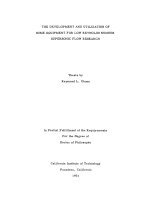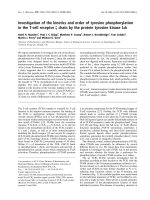The development and evolution of dominant logic in an innovation project
Bạn đang xem bản rút gọn của tài liệu. Xem và tải ngay bản đầy đủ của tài liệu tại đây (939.34 KB, 79 trang )
THE DEVELOPMENT AND EVOLUTION OF DOMINANT LOGIC
IN AN INNOVATION PROJECT
LI JIA
(B.Eng.(Hons), South China University of Technology)
A THESIS SUBMITTED FOR THE DEGREE OF MASTER OF SCIENCE THESIS
DEPARTMENT OF INFORMATION SYSTEMS
SCHOOL OF COMPUTING
NATIONAL UNIVERSITY OF SINGAPORE
2012
Acknowledgements
The successful completion of this thesis is made possible with the guidance and
encouragement from many individuals in my academic and personal life.
First and foremost, my heartfelt thanks to my supervisor, Professor Pan Shan Ling,
who provided me with the opportunity to explore the strategic implications of
information technology in organizations. I have benefitted tremendously from his
imparting of skills for case study, his patience and his encouragement in the face of
difficulties. Most importantly are the precious pearls of wisdom on life he has
sincerely imparted.
My appreciation too to my teammates. It is my honor to have worked with them.
Their insightful comments on my research, as well as their selfless help and
encouragement, have made life in Singapore much easier for me. Special thanks are
due to Derek, who acted as both my academic advisor and personal mentor.
In addition, I sincerely thank all my lecturers for their positive encouragement during
the two-year period of my Master’s program. With their guidance I not only passed
the qualifying examination but also accumulated sufficient knowledge to conduct
research independently.
Special thanks to the interviewees in Fuzzyeyes who enabled me to enjoy an exciting
project.
Last but not least, I am grateful to my parents’ for their never-ending support, without
which none of my achievements would be realized.
i
Table of Contents
Acknowledgements ................................................................................................... i
Table of Contents ..................................................................................................... ii
Summary ................................................................................................................. iv
List of Tables ............................................................................................................v
List of Figures ...........................................................................................................v
Chapter 1: Introduction .................................................................................................1
Chapter 2: Theoretical Background ..............................................................................4
2.1 Existing Perspectives on Innovation ...................................................................4
2.2 Conceptualization of Dominant Logic ................................................................7
2.3 How Dominant Logic Has Developed ..............................................................10
2.4 How Dominant Logic Has Evolved ..................................................................12
Chapter 3: Research Methodology..............................................................................15
3.1 Research Method Selection...............................................................................15
3.2 Case Selection ...................................................................................................16
3.3 Identification of Dominant Logic .....................................................................17
3.4 Data Collection and Analysis............................................................................19
Stage 1: Interview with the CEO (06/2011-01/2012) .........................................20
Stage 2: Interview with key members of the project team (02/2012-08/2012) ..25
Chapter 4: Case Description .......................................................................................26
4.1 Background of the Video Game Industry .........................................................26
4.2 Organizational Background ..............................................................................28
4.3 Video Game Project: EOT ................................................................................30
4.3.1 Phase 1: Design (08/2005-10/2007)...........................................................30
4.3.2 Phase 2: Production (10/2007-05/2010) ....................................................33
4.3.3 Phase 3: Marketing (09/2008-09/2012) .....................................................36
Chapter 5: Analysis and Discussion ...........................................................................39
5.1 Development of Dominant Logic .....................................................................40
5.1.1 Creativity-oriented Dominant Logic and Its Developmental Process .......40
5.1.2 Rationality-oriented Dominant Logic and Its Developmental Process......42
ii
5.1.3 Optimization-oriented Dominant Logic and Its Developmental Process ..45
5.2 Evolution of Dominant Logic ...........................................................................47
5.2.1 Evolution Path............................................................................................47
5.2.2 Evolution Process.......................................................................................49
Chapter 6: Conclusion.................................................................................................53
6.1 Theoretical and Practical Contributions............................................................53
6.2 Limitations and Directions for Future Research ...............................................55
References ...................................................................................................................57
Appendices ..................................................................................................................64
Appendix A Studies Related to Dominant Logic ...................................................64
Appendix B Summary of Contributions .................................................................66
Appendix C Two-stage Data Collection and Analysis ...........................................67
Appendix D Secondary Data Sources: Examples of Online Sources .....................69
Appendix E Official Interview Schedule and Interviewee Information .................70
Appendix F Organization Chart of Fuzzyeyes and Function of Each Section .......71
iii
Summary
With rapidly technological advances and increased competition, managing innovation
has become increasingly challenging. There are two possible causes for the failure of
a project. One is that managers’ decisions are based on incomplete information. The
other is their adoption of inappropriate routines. To gain insight into successful
innovation project management, a theoretical lens that is able to facilitate the
understanding of issues arising from both causes is necessary. Dominant logic, which
can be viewed as both an information filter and routines, fulfills such a requirement
and is thus adopted in this study. Based on the integrated view, a longitudinal case
study of a video game project is conducted to address how the dominant logic of the
project team develops and evolves in a successful innovation project. The findings are
incorporated into a dual layer process model. The first layer encompasses an
evolution path and two evolution processes, which suggest that dominant logic
gradually evolves during three distinct phases of the innovation project to ensure its
success. The second layer depicts the developmental process of dominant logic in
each phase, which is a specific interactive process between information filter and
routines. Our study complements existing innovation literature by investigating
dominant logic from a process perspective and complements dominant logic literature
by providing a way of clearly depicting its development and evolution, thus offering
overarching guidance on how to manage an innovation project.
Keywords: Innovation, Dominant logic, Information filter, Routine, Case Study
iv
List of Tables
Table 1 Design of Interview Questions ......................................................................19
Table 2 Dominant Logic, Its Development and Evolvement in Phase 1 ....................32
Table 3 Dominant Logic, Its Development and Evolvement in Phase 2 ....................35
Table 4 Dominant Logic, Its Development and Evolvement in Phase 3 and Project
Outcome ..............................................................................................................38
Table 5 Definition of Dominant Logic .......................................................................64
Table 6 Diversified Operationalizations of Dominant Logic .....................................65
Table 8 List of Interviewees and Positions .................................................................70
Table 9 Stage 1 Interviews in 2011.............................................................................70
Table 10 Stage 2 Interviews in 2012...........................................................................70
List of Figures
Figure 1 Video Game Industry Ecosystem .................................................................28
Figure 2 The Development and Evolution of Dominant Logic in an Innovation Project
.............................................................................................................................40
Figure 3 Organizational Structure ...............................................................................71
Figure 4 Project Structure ...........................................................................................72
v
Chapter 1: Introduction
“My mindset swings between dream and money, and it significantly
influences the operation of the project team.”- CEO of Fuzzyeyes
In a world of accelerating change, innovation projects to exploit
product-market opportunities are included on the agendas of all kinds of
organizations, whether they are new start-ups, major corporations, or alliances
among global partners (Dess et al. 1999; Shepherd and Kuratko 2009).
However, the management tasks for innovation projects have become
increasingly challenging due to the intensified global competition, rapid
technological obsolescence and heterogeneous customer demand (Goktan and
Miles 2011; Sauer and Reich 2009). The failure rate of innovation projects
remains high, varying from six out of ten to nine out of ten (Harkema 2003),
and thus urges a breakthrough in the management of such projects.
Findings from extant literature show that the failure of innovation projects can
be attributed to two reasons regarding project management. One is that
managers make decisions based either on their limited experience or on
incomplete information. For instance, when the experience of the management
on a potential project is one-sided and leads them to underestimate it, they are
likely to allocate inadequate resources or even abandon such a project
(Amabile et al. 1996; Song and Parry 1997). Due to the paucity of information
on consumer demand and the competitive environment, a new product is likely
to be positioned in too small a market or scheduled to enter a market too late
(Shepherd and Kuratko 2009). The other cause is that the work routines are
inappropriate for dealing with various issues in the innovation process. For
1
example, inefficient communication and collaboration within a project team is
fatal for the delivery of a high quality product on time (Hoegl and Gemuenden
2001). Moreover, routines for dealing with stakeholder relationships (Karlsen
2002), the learning process (Keller 1992) and how the leader sets and monitors
performance targets also significantly influence the results of the project.
Clearly, both causes are behind the failure of many innovation projects. They
could be significantly reduced if a theoretical lens that can facilitate the
understanding of issues arising from both causes is developed. Informed by
previous literature, dominant logic, which refers to “the way in which the
managers conceptualize and make critical resource allocation decisions”
(Prahalad and Bettis 1986), is viewed as both an information filter and
routines (Obloj et al. 2010). Therefore, I adopt dominant logic as a new
perspective in investigating innovation project management on the premise
that the existing theory of dominant logic can be extended from the
organizational level to the project level.
However, firstly, since an innovation project encompasses multiple phases and
is characterized by great uncertainty during the complex interaction with
organizational factors and environmental factors (Kanter 1988; Van de Ven
1986), a static dominant logic is insufficient in ensuring project success.
Pisarski et al. (2011) also suggested that a project manager’s cognitive
flexibility and adaptive behavior is a must in facilitating timely reaction to
change. However, research on how dominant logic evolves is limited. Only a
few authors have empirically illustrated the existence of its evolution, mainly
focusing on evolutionary operationalization of dominant logic (e.g., Blettner
2008; Côté et al. 1999; Von Krogh et al. 2000). With those diversified
2
operationalizations, this stream of research remains inconclusive. Moreover,
the evolution process is rarely discussed in existing research.
Secondly, dominant logic remains an abstract and elusive concept with
inconsistent operationalizations (refer to Table 6), which severely restrict its
practical application (Blettner 2008). For example, it is difficult to clearly
describe the nature and type of dominant logics during an innovation project
(Obloj et al. 2010). Thirdly, no empirical research has thus far supported and
improved on existing simplified theoretical discussions on the development of
dominant logic. In these it is regarded as either a condensation process (Bettis
and Wong 2003) or an interactive process (Bettis and Prahalad 1995). Bearing
in mind the existing gaps in the dominant logic literature and in seeking to
understand how innovation projects can be managed, this study addresses the
following research question: How does the dominant logic of the project team
develop and evolve in a successful innovation project? I adopt the case study
as our methodology and select a video game project as the case because its
characteristics fulfill the requirements of a study on dominant logic.
The main part of this paper is organized into five sections as follows. In the
first section, I explore the theoretical background, by reviewing literature on
innovation and dominant logic. In the second section, I present research
methodology on how to identify dominant logic, followed by an explanation
on data collection and analysis. Next, a detailed description of the case is
presented to show empirical findings related to dominant logic. This is
followed by a discussion, which uncovers the research models on the
development and evolution of dominant logic in an innovation project. Finally,
in conclusion, this study draws theoretical and practical implications, and
3
discusses the limitations, with an end to providing directions for future
research.
Chapter 2: Theoretical Background
2.1 Existing Perspectives on Innovation
As an important means in attaining competitive advantage, innovations are
pursued by most organizations in order to grasp internal and external
opportunities (Shenhar and Dvir 2007). Generally, innovation refers to the
creation or adoption of something new that creates business value (Teo et al.
2007) and it is categorized as process, product/service and business innovation
(Baker 2002). Previously, scholars have also distinguished between
incremental and radical innovation, with the former referring to minor changes
based on existing alternatives, and the latter referring to fundamental changes
which create something new (e.g., Dewar and Dutton 1986). Comparatively,
the radical innovations are of high risk but hold the ability to create entire new
industries and destroy existing ones (Golder et al. 2009). In current
environment with intensified competition, companies, especially those
operating in high-tech industries, increasingly depend on their ability to
develop radical innovations for their survival and prosperity (Bernstein and
Singh 2008). Thus, I limit the focus of this study to defining innovation as the
creation of entirely new products/services and its commercialization to gain
4
business value, i.e., radical product/service innovations 1 (adapt from Teo et al.
2007).
Generally, innovations are influenced by the significant changes in their
contexts, and these include increased technical complexity, accelerated
technology change, interdependence on other organizations and rapidly
evolving and heterogeneous customer demand (Arakji and Lang 2007; Sauer
and Reich 2009). Consequently, managing innovations is proving increasingly
challenging, often resulting in a high failure rate. Two streams of innovation
studies have accumulated knowledge on how to increase the innovation
success rate. One steadily growing stream of research contributes towards
identifying various critical success factors for innovation. Examples of these
factors are teamwork quality (Hoegl and Gemuenden 2001), business strategy
(Ritter and Gemünden 2004), appropriate organization structure and decision
architecture (Van Riel et al. 2004), upper management control (Bonner et al.
2002), managerial competence (Hao and Yu 2012) and technological
competence (Ritter and Gemünden 2004). Some review papers have attempted
to classify these factors. For instance, Kleinknecht (2003) clustered them into
project-related, firm-related, product-related and market-related factors.
Another stream of research contributes to identifying effective innovation
mechanisms. Improvisation, which refers to “deliberate creation of novel
activity”, is proposed as one effective mechanism in facilitating creativity
(Crossan et al. 2005) and enabling innovativeness (Moorman and Miner 1998).
1
In the remaining part of the thesis, “innovation” represents those radical
product/service innovations.
5
It is especially useful in coping with complex, unpredictable and time-critical
issues (Crossan 1998). For resource constrained firms with budget constraints,
a preferable innovation method is bricolage, which means to “make do with
what is at hand” (Baker and Nelson 2005; Senyard et al. 2011). Besides
improvisation and bricolage, effective innovation mechanisms can also be
well-defined organizational structures, management processes and resource
allocation systems that facilitate innovation (Shah et al. 2010).
In spite of the extensive research on various critical success factors and
effective innovation mechanisms, how to successfully manage an innovation
remains obscure because all existing studies have ignored the multi-phase
nature of innovation. Schumpeter (1939) originally defined innovation as
encompassing the entire process, starting from a kernel of an idea and
continuing through all the steps to reach a marketable product that changes the
economy. Innovation is usually dependent on a project (Shenhar and Dvir
2007) and the project is divided into several phases, from ideation to launch,
where the final success is achieved through ensuring that “the right projects
are done and they are done right” at each checkpoint (Cooper and Edgett
2012). This Stage-Gate process is especially useful in innovations which are
characterized by the inability of accurately estimating and controlling costs
and delivering on time and within budget (Davies et al. 2011). In dealing with
the conflict between creativity and organizational constraints, the Stage-Gate
process is also feasible for implementing each phase with different focuses
(e.g., Cohendet and Simon 2007). As a result, a process view is strongly
recommended when investigating how to successfully manage innovation.
6
In addition to various critical success factors in project management, whether
the “dominant mindset” of the project managers is appropriate is also a critical
factor for innovation success because their mindset determines how they direct
the project team to react to changes (adapt from Sauer and Reich 2009). Hence,
I adopt dominant logic (i.e., “dominant mindset”) as a new and useful
theoretical perspective in innovation studies. During the innovation process,
managers’ dominant logic evolves to deal with ever-changing challenges. In
the following section, dominant logic literature is reviewed and organized into
three parts, i.e., conceptualization, development and evolution.
2.2 Conceptualization of Dominant Logic
Dominant logic is defined as the “way in which managers conceptualize the
business and make critical resource allocation decisions-be it in technologies,
product development, distribution, advertisement or in human resource
management” (Prahalad and Bettis 1986). This concept has evolved in three
stages. Firstly, in the original paper, dominant logic was applied to the
dominant coalitions or the top management team of a (diversified)
organization (Prahalad and Bettis 1986), with cognitive psychology as its
underlying theory (Bettis 2000). Secondly, in Bettis and Prahalad (1995)’s
second paper, the dominant logic of the entire organization was adopted
through “retrofitting” (Krogh and Roos 1996) the concept to the theory of
complex adaptive systems (Bettis and Prahalad 1995). Since then, it has
become widely accepted as an organizational level concept (Jarzabkowski
2001; Von Krogh and Grand 2000).
7
Thirdly, it is undeniable that this concept can be applied at any level as long as
the management procedure, including the style and process of management
and the key resource allocation choices, are significantly influenced by a
“collection of key individuals” (i.e., a dominant coalition) (Donaldson and
Lorsch 1983; Prahalad and Bettis 1986). In this manner, it can be broadly
applied at the project level, business unit level (Prahalad and Bettis 1986),
organizational level (Bettis and Prahalad 1995; Lampel et al. 2000), business
group level (Ray and Chittoor 2005) and industry level (Brännback and
Wiklund 2001; Sabatier et al. 2012). In this study, I extend its application to
project level, where the project managers enjoy high autonomy in decision
making. Similar to the argument that the dominant logic of a firm is one key
factor in the success of a new venture (Nadkarni and Narayanan 2007), we
posit that the dominant logic of the project team is a determinant for the
success of an innovation project.
Based on extant literature summarized in Appendix A, it can be inferred that
the operationalization of dominant logic are varied and lacking in consistent
criteria. Existing research is perceived as belonging to two streams, i.e.,
dominant logic as an information filter and dominant logic as a set of routines
(Obloj et al. 2010). These two streams are also implied in the original paper
simultaneously, where “the dominant logic can be considered as both a
knowledge structure and a set of elicited management processes” (Prahalad
and Bettis 1986). Therefore, by combining both views it is possible to produce
a consistent and comprehensive operationalization of dominant logic, which is
beneficial in unifying all existing discussions. Next, I examine both views
separately.
8
Dominant logic as an “information filter” was first discussed in Bettis and
Prahalad (1995)’s study, where it directed the management to “sift” relevant
information and make strategic decisions. Von Krogh et al. (2000) attempted
to extend this view by adding dominant logic as a lens. In their study,
dominant logic, on the one hand, functions as a funnel that facilitates top
management teams in filtering information based on their experience to form
perceptions; on the other hand, dominant logic functions as a lens that
facilitates top management teams in seeing the imaginable future (Von Krogh
et al. 2000). Similarly, dominant logic is perceived as “mental models” or
“knowledge structures” or “set of schemas” (Bettis and Prahalad 1995), which
are composed of managers’ interpretations of experiences in core businesses
and formed after a period of time. In this sense, dominant logic allows
managers to analyze data and respond to any emergent uncertain situations
efficiently without adopting scientific methods (Prahalad and Bettis 1986). In
other words, managers leverage on their mindsets to selectively scan
environments and make timely decisions (Hambrick 1982). Whatever the
perceptions of researchers, they point to the important information processing
function of dominant logic (Von Krogh et al. 2000).
In addition, most other researchers perceive dominant logic as “routines” in
their studies (Blettner 2008; Obloj et al. 2010). They have adopted this
behavioral view because it is extremely difficult to operationalize dominant
logic as a cognitive concept (Blettner 2008; Grant 1988; Prahalad and Bettis
1986). Initially, Grant (1988) explored three critical specific corporate-level
functions-allocating resources, formulating business strategies, and setting
and monitoring performance targets-as reflections of dominant logic. This
9
attempt is based on part of the original definition of Prahalad and Bettis (1986),
where “dominant logic is reflected in the administrative tools to accomplish
goals and make decisions”. The like-minded researchers insisted on a
combination of behavioral and cognitive operationalization (Blettner 2008).
Examples of behavioral components are resource allocation (Von Krogh and
Grand 2000), embedded administrative processes (Jarzabkowski 2001),
actions of top management (Jarzabkowski 2001), dominant routines and
learning experiences (Obloj et al. 2010).
To sum up, dominant logic can be extended to the project level as a key
determinant
for
the
innovation
project
success.
The
integrated
operationalization of dominant logic both as an information filter and routines
is also explained in detail in this section. However, the “path-dependent”
nature of dominant logic (Krogh and Roos 1996; Prahalad and Bettis 1986),
where it is a result of past experiences (Von Krogh et al. 2000), determines the
dynamic property of the concept. Managers are also required to adjust their
dominant logic to adapt to the dynamic markets (Von Krogh et al. 2000). In
the next section, I explore the development process and evolution process of
dominant logic.
2.3 How Dominant Logic Has Developed
Several researchers have proposed theoretical discussions on the development
of dominant logic but lack empirical support. The few existing discussions can
be classified into two streams. The first stream of research in simplifying the
actual development process, views it as a condensation process, in which the
general manager’s shared mindset is gradually condensed into organizational
10
features and then these organizational features reinforce the dominant logic
through a positive feedback loop (Bettis and Wong 2003). Blettner (2008)
further extended the simplification by explaining the condensation process
using the coherence theory, and by likening the condensation process to the
evolution of coherence. Specifically, he adopted a knowledge-based view of
dominant logic, stressing how knowledge increases in density as well as how a
core knowledge structure is formed in an organization. The second stream of
research regarded the development of dominant logic as an interactive process.
For example, Bettis and Prahalad (1995) in their study argue that current
dominant logic will affect the organizational learning activities, which occur at
the level of the strategy, systems, values, expectations and reinforced
behaviors; the outcomes of these activities would then shape the dominant
logic through either positive or negative feedback.
In adhering to the second stream of study, many researchers embedded the
interactive process into the behavioral and cognitive operationalization of
dominant logic (e.g., Jarzabkowski 2001; Von Krogh et al. 2000), where
dominant logic consists of “not only how the members of the organization act
but also how they think” (Prahalad 2004). Intuitively, the cognitive component,
i.e., how they think and the behavioral component, i.e., how they act, would
exert an influence on each other. However, none of these researchers
elaborated on how the two components would interact (e.g., Jarzabkowski
2001). It is probably rooted in the limitation that dominant logic is regarded as
a cognitive concept in those studies. In a similar vein, despite the abundant
research in regarding dominant logic either cognitively as an information filter,
or behaviorally as a set of routines, the interaction between the two views is
11
totally ignored. In fact, these two views are closely related. According to
Obloj et al. (2010), “routines may be an integral component to the formation
of knowledge filters, and as structuration theory suggests, these knowledge
filters will, in turn, influence subsequent behavior”. Hence, instead of
discussing the development of two views separately, it would be meaningful to
combine these two views into an interactive process that explains the
development process of dominant logic. I propose that, in a specific
environment, the filtered information should guide the development of
necessary routines, and in return, some learned experience (Levitt and March
1988) and feedback (Daft and Weick 1984) should shape the information filter
in certain ways (Bettis and Wong 2003). After a period of interaction, a
specific dominant logic is developed.
This section provides a brief literature review on how dominant logic has
developed. Generally, the developmental process of dominant logic as an
interaction process between the cognitive and behavioral components is of
great interest. With the integrated operationalization of dominant logic
proposed in the last section, I proceed to explain the interactive process in
greater detail within the context of this study.
2.4 How Dominant Logic Has Evolved
Previous research has mainly investigated organizational dominant logic by
consideration of the industry dynamics (Bettis and Prahalad 1995; Obloj et al.
2010). It is inert to change in stable environment because of its “operant
conditioning” characteristic, which refers to the process by which behaviors
that work are reinforced while others are ignored or reduced over time (Bettis
12
and Prahalad 1995; Jarzabkowski 2001; Prahalad and Bettis 1986). In contrast,
in extremely turbulent environments, dominant logic is neither stabilized nor
embedded into the organizational features (Bettis 2000). In dynamic
environments, it is suggested that dominant logic must evolve to deal with
emergent environmental cues (Bettis and Wong 2003). However, it is difficult
to observe such evolution. Most earlier researchers argue that dominant logic
is inherently an adaptive property (Bettis and Wong 2003) but is resistant to
being unlearned and difficult to change (Jarzabkowski 2001; Prahalad and
Bettis 1986). They assume that the evolution extends over an extensive period.
For instance, many outstanding companies insist only on doing what has been
successful in the past and finally fail to adapt to a changing environment
because they fail to alter their existent dominant logic (Sull 1999).
Nevertheless, several authors have successfully captured the evolution of
dominant logic in their studies. For instance, Von Krogh et al. (2000)
investigated the change in the “bandwidth” of dominant logic to illustrate its
evolution in the telecommunication industry. The “bandwidth” is calculated
based on six dimensions contained in dominant logic and they are related to
the internal and external environment. Côté et al. (1999) perceived a change of
dominant logic from three totally different dimensions based on an acquisition
case. Other researchers focused on changes in “condensed” or “coherence”
elements of dominant logic during its evolution (Blettner 2008; Jarzabkowski
2001). Despite these existing studies, research on the evolution of dominant
logic remain inconclusive because they have adopted very different criteria to
illustrate the evolution (Blettner 2008). To unify the criteria, a consistent
operationalization
is
required
(Blettner
13
2008).
The
integrative
operationalization of dominant logic both as an information filter and routines
is optimal because it unifies all existing discussions.
Moreover, due to the difficulty in distinguishing between different dominant
logics, the process of evolving from an old dominant logic to a new one is
under-researched. The only theoretical explanation on how dominant logic
evolves is a three-step process: (1) initially it involves a “fit” between
dominant logic and strategic choices; (2) some new strategic choices are made
based on the changing conditions, which result in a disturbed “fit” and
possible negative performance effects; (3) revising or adding a new dominant
logic into the portfolio to recover the “fit” (Bettis and Prahalad 1995).
The
third step is usually a “revision” process because to totally unlearn an old
dominant logic is difficult and to add a new dominant logic usually results in
conflict (Bouwen and Fry 1991). Even the revision is a difficult process and
includes unlearning partial dominant logic and learning some new elements
(Bettis and Prahalad 1995). That explains why new entrants sometimes
surpass the experienced incumbents in facing industrial change (Sull 1999).
For those adding a new dominant logic, a designed process, such as the dialog
process (Bouwen and Fry 1991), is required. Failing this, the failure rate is
high. For example, when the new CEO of Hewlett-Packard (HP) directly
substituted the old and solid Hardware logic with the new Service logic,
conflicts erupted, throwing HP into chaos. Several similar conflicts have
occurred in HP during the last 10 years, leading to a significant decline in
performance (Franklin and Mujtaba 2011).
The above discussion on how dominant logic evolves is too general. To
further explore this stream of research, there are three possible directions. The
14
first and foremost direction is to identify the evolution path by distinguishing
different dominant logics. Ortiz (2009) has made a trial of labeling dominant
logic with an explorative or exploitative orientation, where the orientation
influences a firm’s critical resource allocation decision. The second alternative
is to classify and specify the evolution process to decipher how dominant logic
evolves from an old to a new dominant logic. The third direction, i.e., the
investigating of the evolution mechanism is meaningful as both researchers
and practitioners are attracted by the following research question: “How can
the evolution of dominant logic be successfully managed?”
Chapter 3: Research Methodology
3.1 Research Method Selection
I preferred qualitative research to quantitative research because the former
complies with the aims of this study. Our aims are to understand a complex
phenomenon in context-specific settings and extrapolate it to similar situations
through detailed interviewing and observation (Golafshani 2003; Hoepfl 1997;
Patton 2002). Among various qualitative research methods, the case study is
particularly appropriate for this study for four reasons. First, the case study is a
widely accepted inductive method for exploratory research in the IS discipline
(Mingers 2003) and is suitable for answering “how” and “why” questions
(Walsham 1995). Indeed, both our research questions are “how” questions.
Second, the case study is particularly useful for unearthing processes (Gephart
Jr 2004) over time and our study seeks to understand the developmental and
evolution process of dominant logic. Third, studying a complex phenomenon
in an epistemological context, such as dominant logic, suggests the adoption
15
of case study (Ray and Chittoor 2005). Fourth, dominant logic is bound up
with its context and is thus difficult to discern through the positivist method
(Klein and Myers 1999). As the case study is ideal for exploring the dynamics
within single settings (Eisenhardt 1989), I adopt it to study an innovation
project in detail, which allows us to probe deep into the contextual issues and
provide a better intellectual grip on the conceptual fuzziness surrounding the
concept of dominant logic.
3.2 Case Selection
The six-year game software project (EOT) I studied was conducted by
Fuzzyeyes, an Australian multimedia software development company in the
computer game industry. The Australian game industry is appropriate for our
dominant logic study for two reasons. Firstly, several authors have
recommended studying dominant logic in changing environments (Von Krogh
and Grand 2000; Zietsma et al. 2002), and the game industry is facing
unexpectedly swift growth in the market (Shen and Altinkemer 2008) as well
as being highly dynamic with continuous change in technology and art trends.
Secondly, the game industry, which belongs to the software sector (Storz
2008), is characteristically under-regulated by authorities, with few standards
and no patents (Liebeskind 1996). Consequently, it offers ample opportunities
for entrepreneurial activities (Blettner 2008). In Australia, many game studios
are booming (Haukka 2011). To survive in this loosely regulated industry in
the midst of intense competition, a game project manager’s mindset must be
adaptive or even proactive.
16
Furthermore, I prefer independent studios like Fuzzyeyes to project teams in
large corporations because the latter do not enjoy complete autonomy in
decision making (Allen and Panian 1982) and thus the dominant logic of the
project managers is influenced by the dominant logic of the large corporation.
Generally, the dominant logic of a corporation is inert to change because of
the proven difficulty in implementing such changes (Bettis and Wong 2003;
Jarzabkowski 2001; Sull 1999). As a result, dependent project teams cannot
flexibly adapt instantly to any changes in the environment. Comparatively,
independent game studios, especially those operating on a small scale which
are characterized by limited resources and thus cannot afford failure (Wiklund
and Shepherd 2005), tend towards adjusting their dominant logic to adapt to a
turbulent environment.
Finally, a longitudinal study is necessary to investigate the evolution of
dominant logic (Obloj et al. 2010). Among all the projects, only some
innovative software projects, such as groundbreaking game/movie projects,
occupy extensive periods and allow a manager’s risky behavior to adapt to the
dynamic environment. The EOT is one such project that extends over six years,
and the entire project teams, including the CEO, do their utmost to produce the
game and make it survive in a competitive environment. Generally, the EOT
project provides a perfect context for us to explore the development and
evolution of dominant logic.
3.3 Identification of Dominant Logic
Our approach for the measurement of dominant logic is derived from Obloj et
al. (2010)’s integrative model where dominant logic is conceptualized both as
17
an information filter and routines. Based on this model, I identify dominant
logic from the perspectives of managers’ strategic schemas/mindsets and key
project activities such as decision making and working procedures. Managers’
schemas are shaped by their critical experience. Their influence is
incorporated into the project processes through sense-giving or other
managerial activities (Hill and Levenhagen 1995) and reflected in the project’s
strategy, team values, expectations and reinforced behaviors (Bettis and
Prahalad 1995). Hence, in our study, the dominant logic of the project
managers was sought to be deduced through interviews with key managers in
the project team. Primarily, I interviewed the project manager of the
innovation project, who was also the CEO of the organization. To align with
previous studies, I first identified dominant logic using Bettis and Prahalad
(1995)’s method, and interviewed the CEO on “his basic views of strategy and
industry”. In subsequent interviews with the CEO and other key managers,
critical decisions, working routines, organizational culture, and structure were
identified under the context of the project. The guiding questions adopted in
our interviews are listed in Table 1.
Compared to previous researches, this integrative method has the advantage of
reducing the difficulty in identifying a dominant logic and increasing the
accuracy of excavating or deducing the dominant logic. Previously, Ray and
Chittoor (2005) measured dominant logic as a set of decision rules that were
etched into the top managers’ minds, which created the problem that these
rules might cover too broad a range of issues due to the managers’ complex
experiences. Bettis and Prahalad (1995)’s classical method, which is to
interview the managers on their “basic views of strategy and industry”, shares
18









